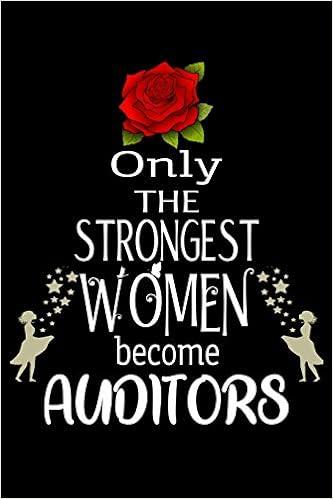Question
9. Expenses are: A. cash disbursements. B. decreases in net assets from uninsured accidents. C. decreases in net assets from dividends to stockholders. D. decreases
9. Expenses are: A. cash disbursements. B. decreases in net assets from uninsured accidents. C. decreases in net assets from dividends to stockholders. D. decreases in net assets resulting from usual operating activities.
11. The Statement of Changes in Owners' Equity shows: A. the change in cash during a year. B. revenues, expenses, and liabilities for the period. C. net income and dividends for the period. D. paid-in capital and long-term debt at the end of the period.
13. Retained Earnings represents: A. the amount invested in the entity by the owners. B. cash that is available for dividends. C. cumulative net income that has not been distributed to owners as dividends. D. par value of common stock outstanding.
14. Additional paid-in-capital represents:
A. The difference between the total amounts invested by the owners and the par or stated value of the stock.
B. Distributions of earnings that have been made to the owners. C. Distributions of earnings that have not been made to the owners. D. The summation of the total amount invested by the owners and the par or stated value of the stock.
15. The Statement of Cash Flows:
A. Shows how cash changed during the period. B. Is an optional financial statement. C. Shows the change in the market value of the entity's common stock during the period. D. Shows the dividends that will be paid in the future.
16. On January 31, an entity's balance sheet showed total assets of $750 and liabilities of $250. Owners' equity at January 31 was:
A. $500 B. $1,000 C. $750 D. $250
17. On January 31, an entity's balance sheet showed net assets of $1,025 and liabilities of $225. Owners' equity on January 31 was:
A. $800 B. $1,025 C. $1,250 D. $225
18. At the end of the year, retained earnings totaled $1,700. During the year, net income was $250, and dividends of $120 were declared and paid. Retained earnings at the beginning of the year totaled:
A. $2,070 B. $1,330 C. $1,230 D. $1,570
At the beginning of the fiscal year, the balance sheet showed assets of $1,364 and owners' equity of $836. During the year, assets increased $74 and liabilities decreased $38.
19. Owners' equity at the end of the year totaled:
A. $836 B. $872 C. $948 D. $1,438
20. Liabilities at the end of the year totaled:
A. $490 B. $528 C. $836 D. $910
At the beginning of the year, paid-in capital was $82 and retained earnings was $47. During the year, the owners invested $24 and dividends of $6 were declared and paid. Retained earnings at the end of the year were $52.
21. Total owners' equity at the end of the year was: A. $82 B. $94 C. $106 D. $158
22. A firm's net income for the year was $200,000. Average assets totaled $1.5 million, and average liabilities totaled $0.3 million. Return on equity was:
A. 13.3% B. 16.7% C. 10% D. 20%
23. Which of the following is not usually considered a measure of an entity's liquidity?
A. Current ratio. B. Acid-test ratio. C. Cash ratio. D. Working capital.
24. A current ratio of 6 is usually an indication that the firm:
A. Has a low degree of liquidity. B. Has a reasonable degree of liquidity. C. Has not made the most productive use of its assets. D. Has made the most productive use of its assets.
25. For a firm that presently has a current ratio of 2.0, the effect on this ratio of paying a current liability is:
A. Raises the current ratio. B. Lowers the current ratio. C. Doesn't affect the current ratio. D. Depends on the amount paid.
26. Which of the following is a universally accepted measure of profitability?
A. Rate of return on investment. B. Rate of return on retained earnings. C. Rate of return on liabilities. D. All of these.
Step by Step Solution
There are 3 Steps involved in it
Step: 1

Get Instant Access to Expert-Tailored Solutions
See step-by-step solutions with expert insights and AI powered tools for academic success
Step: 2

Step: 3

Ace Your Homework with AI
Get the answers you need in no time with our AI-driven, step-by-step assistance
Get Started


